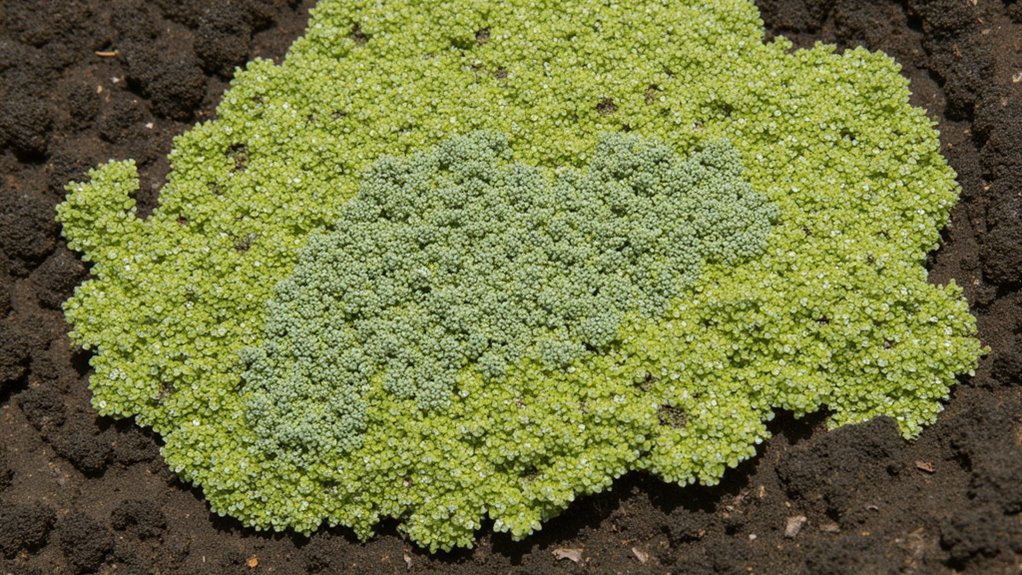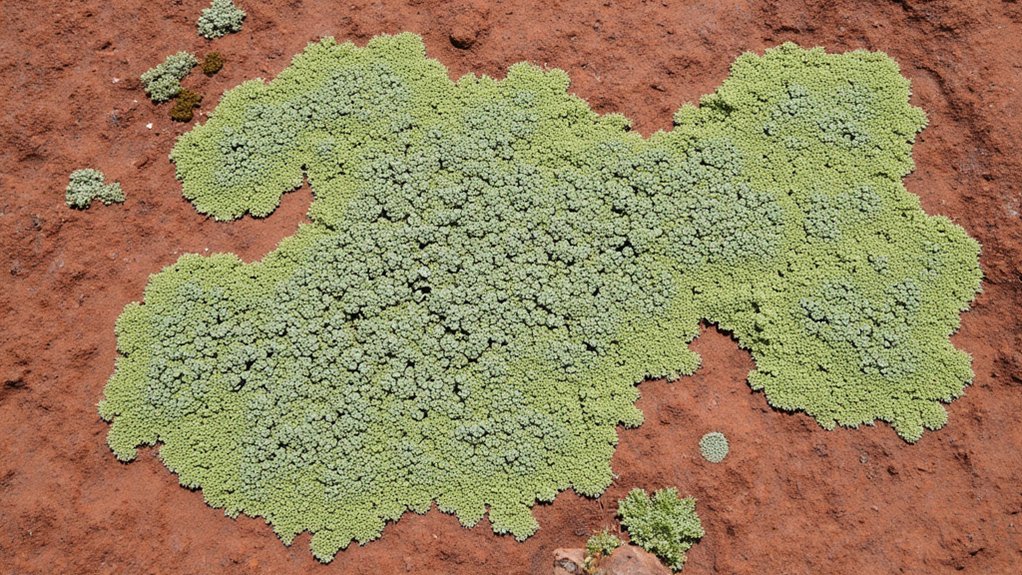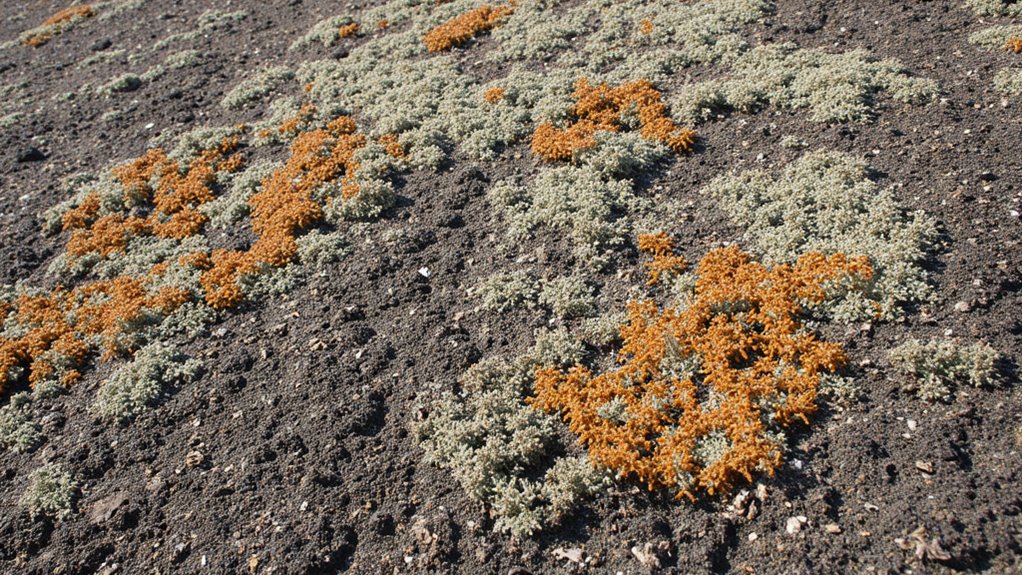You’ve probably walked past countless lichens without realizing what extraordinary partnerships they represent. These remarkable organisms, which you’ll spot colonizing rocks, trees, and walls, aren’t single species at all – they’re intricate alliances between fungi and algae. While the fungus builds the foundation and gathers minerals, its algal partner busily converts sunlight into food. It’s a collaboration that’s conquered every continent, and there’s much more to their story than meets the eye.
Contents
- 1 The Building Blocks: Understanding Fungi and Algae Partners
- 2 A Perfect Marriage: How the Symbiotic Relationship Works
- 3 Survival Masters: Adapting to Extreme Environments
- 4 Nature’s Environmental Indicators: Lichens as Biomonitors
- 5 The Hidden Language: Chemical Communication Between Species
- 6 Ancient Alliance: The Evolutionary Journey of Lichens
The Building Blocks: Understanding Fungi and Algae Partners

While you might think of lichens as a single organism, they’re actually made up of two distinct partners working together – fungi and algae. In this remarkable partnership, the fungi provide structure and protection, forming up to 90% of the lichen’s mass.
The algal cells, nestled within the fungal tissue, act as the food producers through photosynthesis. You’ll find these photosynthetic partners are usually green algae or cyanobacteria, converting sunlight into sugars that both organisms can use.
The fungal partner creates a protective outer layer that shields the algae from harsh environmental conditions, while also absorbing water and minerals from the surrounding environment.
A Perfect Marriage: How the Symbiotic Relationship Works

The symbiotic relationship between fungi and algae in lichens represents one of nature’s most successful partnerships, functioning like a well-oiled machine. Within this intricate alliance, you’ll find the fungus providing structure, protection, and water retention, while the algae handles photosynthesis, creating essential nutrients.
Think of it as a miniature solar-powered factory: the algal cells, nestled within the fungal tissue, convert sunlight into sugar, sharing up to 80% with their fungal host. The fungus, in turn, shields these precious algal cells from harsh environmental conditions, including UV radiation and desiccation, while anchoring them firmly to various surfaces.
Survival Masters: Adapting to Extreme Environments

Because lichens have mastered the art of survival, you’ll find these remarkable organisms thriving in some of Earth’s most inhospitable places. From the scorching Atacama Desert to Antarctica’s frozen valleys, lichens demonstrate incredible resilience.
You’ll spot them growing on bare rocks at elevations above 20,000 feet, where temperatures drop to -60°F. Their secret lies in their ability to enter a state of cryptobiosis, fundamentally becoming dormant until conditions improve.
Unlike most living things, lichens can absorb water directly from humid air, and they’ll survive prolonged droughts by drying to just 2% of their normal water content without dying.
Nature’s Environmental Indicators: Lichens as Biomonitors
Modern scientists rely heavily on lichens as natural environmental detectors, thanks to their remarkable sensitivity to air quality and pollution levels. You’ll find these organisms serving as nature’s warning system, absorbing and accumulating airborne pollutants that can later be measured in labs.
When you’re studying environmental health, lichens provide clear signals. Their presence, or absence, tells you about sulfur dioxide levels, heavy metals, and radioactive particles in the area. They’re so reliable that researchers often map lichen distributions to track pollution patterns across cities and industrial zones.
Scientists can extract and analyze trapped pollutants from lichen tissue, creating detailed pollution histories spanning decades.
While fungi and algae merge to form lichens, they’re constantly exchanging chemical signals in a complex molecular conversation. You’ll find that these organisms use specialized compounds, like mycobionts and phycobionts, to coordinate their growth and metabolic activities.
When you examine their communication closely, you’ll notice that fungi release specific proteins called lectins, which bind to the algal cell walls. The algae respond by producing their own chemical signals, including sugar alcohols and vitamins that the fungi need to survive.
This chemical dialogue helps them maintain their unique partnership and adapt to environmental changes together.
Ancient Alliance: The Evolutionary Journey of Lichens
Throughout Earth’s history, dating back over 400 million years, lichens have formed one of nature’s most enduring partnerships. They’ve colonized nearly every terrestrial environment, from scorching deserts to frozen tundra, evolving alongside Earth’s changing landscapes.
You’ll find that these pioneering organisms first appeared during the Devonian period, when they helped create soil by breaking down rocks. Through genetic studies, we’ve learned that this symbiosis evolved independently multiple times, with different fungal species forming partnerships with various algae.
Today’s lichens represent the successful descendants of those ancient alliances, carrying genetic traces that tell the story of Earth’s earliest plant-like colonizers.
